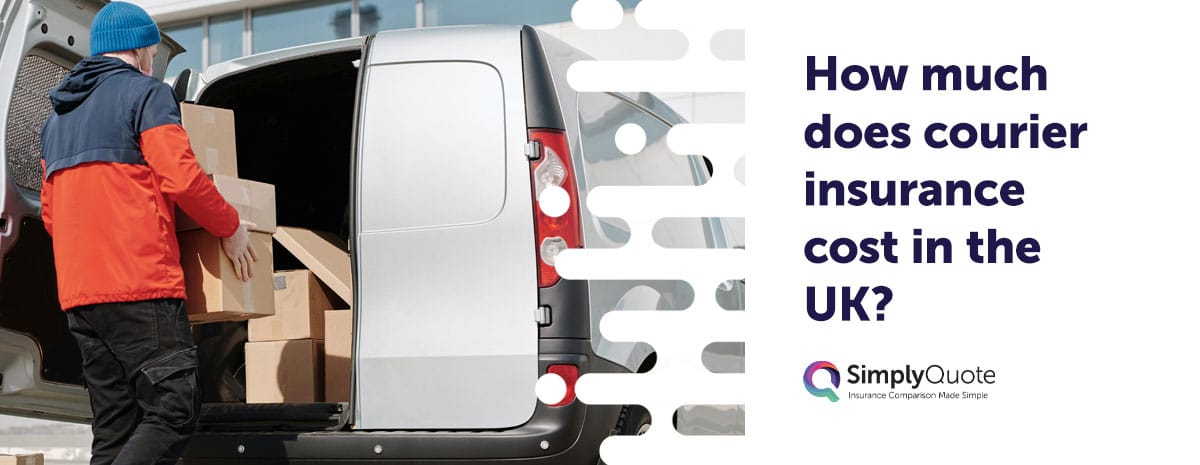How much does courier insurance cost in the UK?
Courier insurance in the UK usually costs between £1,450 and £2,150 per year for van drivers, and upwards of £1,000 for car-based couriers.
These are 2025 figures based on comprehensive cover—and they reflect the unique risks of using a vehicle to earn a living.
Courier work comes with more exposure than standard driving. You’re on the road for longer, under pressure to hit deadlines, often carrying valuable or fragile goods—and frequently operating in high-traffic or high-risk areas. That level of activity pushes up premiums well beyond what you’d pay for personal car insurance.
For context, a recent Zego quote for a five-year-old Ford Transit shows annual costs starting at £1,450 for third-party cover, rising to £1,944 for comprehensive. Other insurers, like Quote Detective and Principal, have quoted closer to or even above £2,300 depending on the driver profile and coverage.
If you’re using a car rather than a van, don’t expect it to be cheaper by default. In many cases, younger or less experienced car-based couriers—especially those doing food delivery—may pay as much, if not more, than van drivers with good histories.
Courier insurance is a business expense, not just a formality. And the price you pay depends on far more than just the vehicle you drive. In this guide, we’ll unpack what affects your premium, what different policies include, and how you can reduce your overall cost.

What factors affect courier insurance prices?
Courier insurance costs are driven by risk—and insurers assess that risk across multiple variables, from your vehicle to your delivery habits to where and what you transport.
Two couriers doing the same job can pay very different premiums based on their profile.
Here are the key pricing factors:
Type of Vehicle
Vans tend to be cheaper to insure than cars in the courier world—not because they’re less valuable, but because insurers understand the risk profile better. A 5-year-old Ford Transit doing multi-drop deliveries is a known quantity. A high-performance hatchback doing the same job? That’s a wildcard.
Driver Age & Experience
A 38-year-old driver with 10 years’ no-claims is going to pay significantly less than a 22-year-old just starting out. Insurers view experience as a predictor of risk. No surprises there.
Driving History
Past accidents, insurance claims, or penalty points on your licence will push your premium up. A clean record can bring meaningful savings.
Mileage & Delivery Area
Someone delivering in central London or covering 40,000 miles a year is going to face higher costs than a part-time rural courier. More miles = more risk. Urban zones = higher accident and theft exposure.
Type of Goods Carried
Food delivery is generally lower risk than high-value electronics or specialist medical equipment. Some insurers won’t cover hazardous goods at all—or will quote accordingly.
Level of Cover
Third-party only will always be the cheapest tier, but most couriers opt for comprehensive because they can’t afford downtime or disputes over vehicle damage.
Policy Structure
Annual policies offer better value long term. Pay-as-you-go cover is often favoured by part-timers but can cost more per day. Fleets may benefit from group discounts.
Insurers price based on risk exposure, not just job title. Two drivers delivering identical parcels might face very different quotes—one because of postcode, the other because of previous claims. That’s why understanding the drivers of price is so important before you compare.
Looking to compare courier insurance? Get your quote today!
Get QuotesHow much is courier insurance with different providers?
Courier insurance costs can vary by over £1,000 depending on the provider, the cover level, and the driver’s profile.
To help you benchmark what’s fair—and what’s not—here’s a sample of 2025 quotes for a 5-year-old Ford Transit van.
| Provider | TPO | TPFT | Comprehensive |
|---|---|---|---|
| Zego | £1,450 | £1,716 | £1,944 |
| Quote Detective | £2,172 | £2,172 | £2,372 |
| Principal Insurance | N/A | £1,847 | £1,749 |
These quotes assume a mid-risk courier profile—around five years’ experience, clean licence, and moderate annual mileage. The Ford Transit is a common courier van, making it a good benchmark for commercial vehicle pricing.
Zego often leads on competitive pricing for solo van couriers, especially for those willing to share telematics data. Quote Detective’s higher rates reflect wider acceptance of younger or higher-risk drivers—but that flexibility comes at a cost.
It’s also worth noting how the price difference between third-party only and comprehensive narrows at higher levels. In some cases, you’ll only save a couple hundred pounds by stripping out key protections—leaving you underinsured for minimal savings.
If you’re comparing quotes, be careful not to treat TPO or TPFT policies as apples-to-apples unless the cover types, limits, and usage terms are clearly aligned.
What do add-ons like public liability and goods in transit insurance cost?
Public liability insurance for couriers starts from as little as £4.74 per month, while goods in transit insurance typically begins at around £200 per year.
These add-ons are optional, but for many drivers, they’re essential—especially if you’re interacting with the public or transporting high-value goods.
Let’s break that down:
Public Liability Insurance
This protects you if a member of the public is injured or their property is damaged during your work. For example, if you accidentally knock over a customer’s motorcycle while delivering a package, this policy covers the legal and compensation costs.
Goods in Transit Insurance
Covers the items you’re delivering in case of damage, theft, or loss while in your vehicle. Most insurers offer basic goods in transit protection from around £200 per year, but the rate rises quickly for higher-value or sensitive deliveries—like mobile phones, designer goods, or food that requires temperature control.
These add-ons are often bundled with your courier vehicle insurance, especially through brokers or specialist providers. But you can also buy them separately if you’re using a pay-as-you-go vehicle policy or working for multiple platforms.
While not legally required, both policies provide protection that can make or break your business in the event of a claim.
How can you reduce the cost of courier insurance?
To lower your courier insurance costs, focus on reducing your risk profile, tailoring your policy to your actual workload, and choosing providers who specialise in courier cover.
While you can’t change your age or postcode, there are several smart ways to trim your premium without cutting corners on protection.
Here’s how experienced couriers keep their insurance affordable:
- Use Telematics or Dashcams: Some providers offer discounts for drivers who install a black box or dashcam. It proves how you drive—not just where or when. If you drive safely, your premium reflects that.
- Pay Annually Instead of Monthly: Monthly payments almost always carry interest or admin fees. If you can pay the full premium upfront, you’ll likely save 10–20% over the policy term.
- Keep Your Driving Record Clean: Obvious, but essential. Even a minor speeding ticket can bump your premium up at renewal—especially for newer drivers.
- Avoid Over-insuring: If you’re part-time or only doing short-distance runs, don’t pay for cover that assumes 40,000 miles a year. Be realistic when declaring mileage, goods value, and delivery frequency.
- Bundle Policies Where You Can: Fleet insurance or bundling public liability and goods in transit with your vehicle policy often brings cost efficiencies—especially when bought through a broker.
- Choose the Right Vehicle: A sensible van like a Ford Transit is often cheaper to insure than smaller vehicles insurers consider less suitable for courier work. Avoid modifications, tinted windows, or anything insurers flag as “non-standard.”
- Compare Specialist Providers: Mainstream insurers may not understand courier work—or price it competitively. Look to firms like Zego, Principal, or Quote Detective who build policies specifically for your kind of work.
Insurance is ultimately about risk and trust. The more predictable and low-risk you seem to an underwriter, the better your quote will be.
Final thoughts
Courier insurance costs more than standard car cover—and for good reason. When you’re using a vehicle to earn a living, the risks multiply. You’re driving further, carrying goods that don’t belong to you, operating under time pressure, and interacting with the public. A minor incident can turn into a major liability fast.
That’s why getting the right cover isn’t just about ticking boxes—it’s about protecting your income, your vehicle, and your ability to keep working. The price you pay isn’t arbitrary. It’s shaped by how you drive, what you deliver, and how seriously insurers take your risk profile.
If you’re just getting started, take the time to compare quotes from courier-focused providers. Understand what’s included. Know what your policy excludes. And don’t guess—insurers penalise guesswork.
For seasoned drivers, small tweaks can make a big difference at renewal. A dashcam, a mileage update, or trimming back unnecessary extras could shift your premium more than you’d think.
Courier insurance isn’t cheap. But it’s not just a cost—it’s protection that keeps you moving.
Frequently Asked Questions (FAQs)
Yes. Courier insurance costs more because it covers higher risk—longer mileage, time pressure, goods in transit, and public liability exposure aren’t covered by standard car policies.
Not always. Vans like the Ford Transit often attract lower rates than smaller cars used for delivery, as insurers better understand their risk profile.
Yes. Some insurers offer one-day or short-term courier policies—ideal for occasional or seasonal work. However, the daily rate is often higher than annual policies.
Usually, yes. Paying monthly includes interest or admin fees. If you can afford to pay annually, you’ll almost always save money overall.
Third-party only is typically the cheapest form of courier insurance, but it offers limited protection and may not be accepted by all delivery platforms.
Younger drivers face higher premiums due to limited driving history and statistically higher accident rates—especially when paired with high-mileage commercial use.
Not automatically. You usually need to add it separately or purchase it as part of a combined courier insurance package.
Not necessarily. Pay-as-you-go is cost-effective for part-time couriers, but full-time drivers usually get better value with annual cover.
